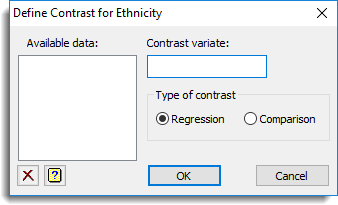Sometimes there may be comparisons between the levels of a treatment factor that you are particularly keen to assess. In this case you can test the power of these individual comparisons using contrasts. This dialog, which appears when you click Define contrast on the Power for REML dialog, lets you specify a contrast for any fixed factor involved in the REML. This contrast is a variate whose length is the number of levels in the factor.

Available data
This lists the variates that can be used for contrasts. Only the variates whose length matches the specified factor will be displayed. Double clicking one of these will move the name to the Contrast variate field.
Contrast variate
Specifies the variate which is used for the contrasts in the REML. You will have needed to set up a variate prior to clicking the Further Output button in the Linear Mixed Model menu. This can be done by creating a new spreadsheet with the same number or rows as there are factor levels in the term being assessed for power and then entering the values for the contrast (see below).
Contrasts have the property that the sum of the values making up the contrast should be zero. The simplest contrast is an individual difference between two levels of a factor and these would be given values -1 and 1. The following table gives common sets of contrasts in a 4 level factor. Any treatment level that is not involved in the contrast is given a value of 0.
The table below shows some of the types of contrast that can be defined.
| Factor level | Contrast type | |||
| A | B | C | D | |
| -1 | 1 | 0 | 0 | Difference between A and B |
| 0 | 0 | -1 | 1 | Difference between C and D |
| -1 | -1 | 1 | 1 | Difference between average of A and B and that of C and D |
| -2 | 1 | 1 | 0 | Difference between A and the average of B & C |
| -3 | 1 | 1 | 1 | Difference between A and the average of B,C and D |
| -3 | -1 | 1 | 3 | Linear trend across A, B, C and D |
Type of contrast
| Regression | The treatment means are regressed against the contrast values. |
| Comparisons | Calculate differences between a combination of treatment effects. The differences to be tested are specified in the Contrast variate. The contrast’s value is the sum of the effects for the factor times their corresponding value in the Contrast variate. |
See also
- REML Power calculations dialog for calculating the power of an REML analysis.
- Further Output for obtaining additional output after fitting a model.
- Linear Mixed Model menu.
- New Spreadsheet dialog.
- VPOWER procedure to calculate the power in a REML model.
- APOWER procedure to calculate the power in an analysis of variance.
- RPOWER procedure to calculate the power in a regression analysis.